Fork
Fork is a pseudo status for forking transitions.
A fork can have one or more incoming transitions. It has several outgoing transitions, which must end in different regions of a composite/orthogonal state. The fork must have the same number of outgoing transitions as there are regions in the composite/orthogonal state.
All outgoing transitions from a fork are completion transitions. They look like normal transitions, because unlike completion transitions they are not displayed with a small circle with a cross in it. However, they are unconditional and output a signal following a concluding event.

A fork is displayed as a black bar; aligned horizontally or vertically.
Properties
"Property" | Description |
|---|---|
"Identifier" | You can enter a name here. It is not displayed in the state diagram. |
"Vertical direction" |
|
Edit fork
User input in the state diagram | Response in the state diagram | Description |
|---|---|---|
Focus on a fork. |
| The fork is editable.
|
Click on the green symbol |
| A completion transition is added. If you click on an existing state, it becomes the target state for the transition. Click on an empty area to create a new state. |
Pull one of the blue |
| The size of the fork has been adjusted. |
Example
Fork with orthogonal states

 : [Default] tick the checkbox to align the bar vertically.
: [Default] tick the checkbox to align the bar vertically. : untick the checkbox to align the bar horizontally.
: untick the checkbox to align the bar horizontally.

 squares to another position.
squares to another position.